Contemporary artist Paula Jenkins talks about how the Australian wilderness is her temple of inspiration, in an interview with Sonalee Tomar for the Asian Curator.
Having not formally studied art, and after following a very different career, my artistic journey involved learning everything the hard way so to speak. Through trial and error, I learnt and developed. The journey of developing and growing will always continue, as it does with any artist. I was a sponge to new ideas, new mediums and methods.

Artist in studio, Paula Jenkins.
Please tell us a little about yourself. What brought you to the world of art and how did you start?
From a very early age the natural environment and creating went hand in hand for me. The more I explored Australia’s bushland and diverse landscapes the more my imagination ran free and I felt a need to capture it. Growing up in the bush and on the land cultivated my strong connection to nature and the terrain. This is where my creative journey commenced. I also grew up in a very creative family. My mum attended National Art School in Sydney and followed a creative path, and my dad was very clever with portraits and drawing.
I started out sketching various landscapes and botanicals when I was young. This was nurtured at secondary school, which was a very creative school, through my art teacher who was very supportive of me and encouraged me to take my art further. However, due to my love of the environment I decided to study environmental management following school and continued my art on the side. It wasn’t until 2013 when I was invited to hold my first solo exhibition that I really sank my teeth into my art, and since then I have established myself as a professional full-time artist.
What is the primary role of an artist? How do you describe yourself in the context of challenging people’s perspectives via your work and art?
The primary role for me as an artist is to express myself through painting. My paintings are essentially an extension of my character, my personality and my life experiences associated with landscapes. Colour is critical in my practice. I’m drawn to using colour as an emotional tool to shift the psyche of the viewer in a positive manner, and importantly energise myself in the process.
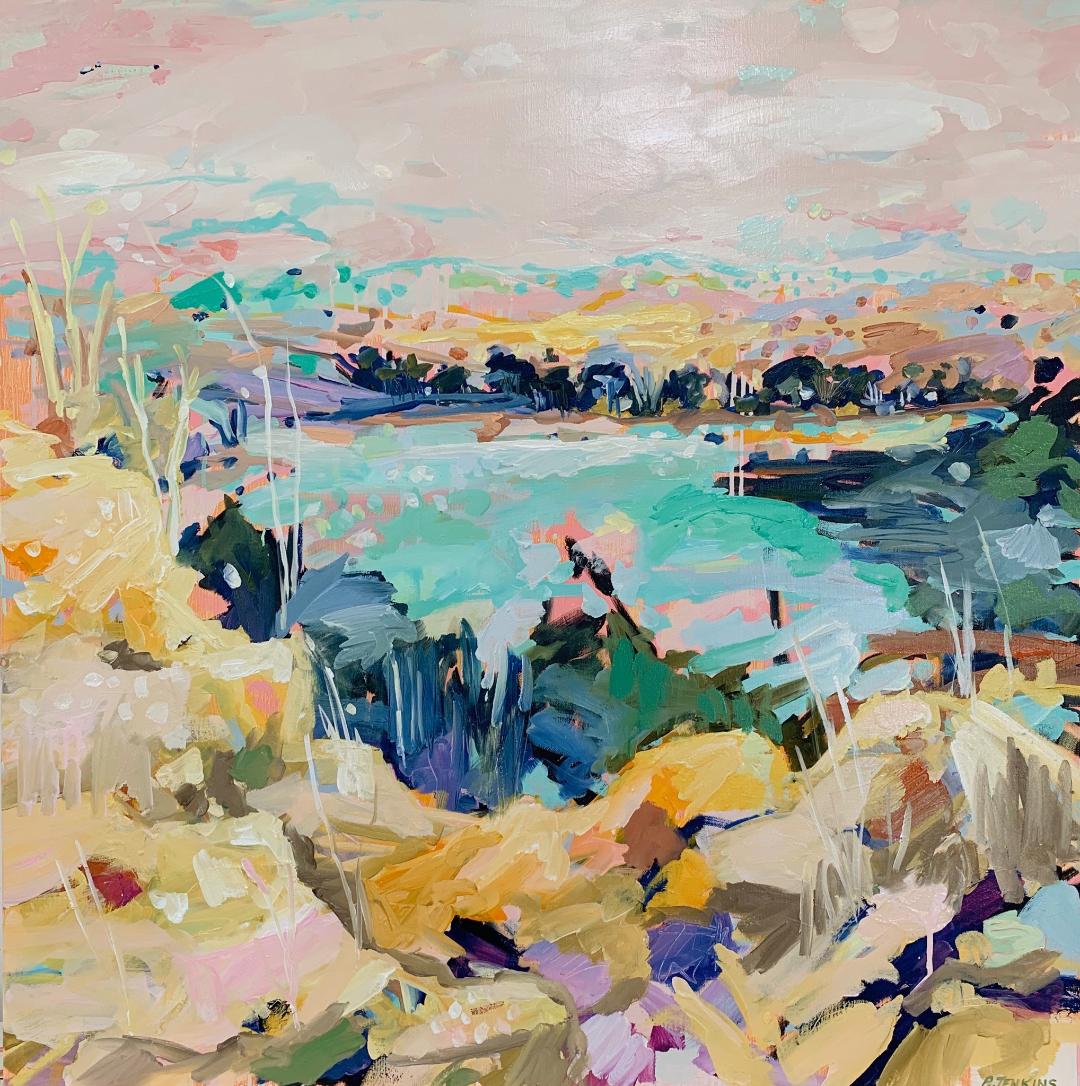
Inland Lake, 102 x 102 cm, oil on canvas.
How do you deal with the conceptual difficulty and uncertainty of creating work?
I rarely begin a painting knowing how it’s going to finish. I work intuitively and spontaneously. This is what I enjoy most about the creative process. The unknown is exciting. I build conceptual meaning along the way, almost to the same degree as I build layers and marks in my paintings.
Let’s talk about your frameworks, references and process. What inspires you?
I need to immerse myself in a landscape prior to creating a painting. I particularly love painting field trips where I can deeply engage in an area, connecting with the elements and all the intricacies of the flora, fauna and terrain; hearing the wildlife; understanding the cultural heritage; and really becoming a part of the environment.
I take numerous photos and complete sketches and small gouache studies in the field to use as references in the studio. The gouache paintings form completed pieces which I include in my exhibitions.
Once I’ve accomplished this, I feel well equipped to create a suite of paintings in my studio based on my time in that area.
I prefer to paint with oils on canvas or board in the studio, and gouache out in the field due to their quick drying time. I begin my oil paintings with an under-colour, followed by sketching out the composition. Once this initial groundwork is completed, I commence the layers to build the painting. I usually have multiple paintings in progress at one time due to the drying time of each layer. For example, at present I have 13 paintings in progress, all at different stages. Once I have the layering to a certain stage, I work on the one painting until it’s complete.

Paula with her painting at Walcha Gallery. Photograph Credit Downtown Magazine/
Is there any topic lately that you would like to be mentored on?
I feel my painting development is taking a natural course over time, something that can’t be ‘taught’ necessarily. Rather I need to explore quietly, slowly and personally. I am, however, open to new approaches and methods.
I am very interested in ceramics and I’m taking a course in this in the upcoming months at the National Art School. I’m quite interested in interweaving ceramics with my paintings, and blending and connecting the two together; adding an ‘earth’ element to accompany my paintings. I’m therefore open to learning everything about ceramics.
What would you call your style?
I’m a contemporary semi-abstract painter and colourist with a focus on direct and subtle mark-making, working in a painterly manner.
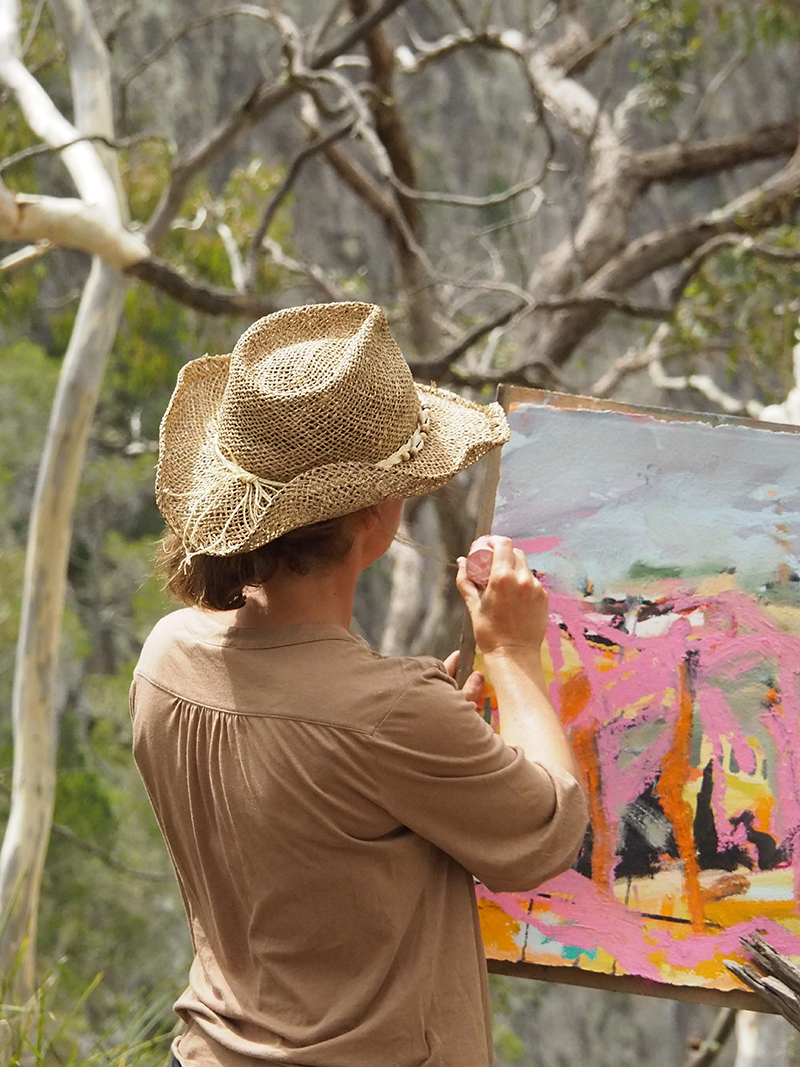
Bush Studio. Apsley Gorge near Walcha.
Let’s talk about the evolution of your practice over the years. Tell us about your commitment to your current medium.
My art has been quite a journey over the years, exploring different mediums and methods. As mentioned earlier, in my younger years I undertook a lot of sketching. I then worked in acrylics and later moved onto pastels after my father gave me a beautiful and extensive Windsor & Newton set. I continued working in pastels for several years, and also created a number of oil stick pieces. Eventually I explored oil paint and gouache, and this is what I am now committed to using. I adore the glossiness and butteriness of oils, and the way I can move the paint around due to its slow drying. There’s a variety of effects I can make with the oils which makes it interesting and exciting. I enjoy using gouache in the field for quick and pigment rich paintings and they are easily transported when travelling and walking in the field.
Let’s talk about your career, or if you prefer artistic journey. What were your biggest learning and hiccups along the way?
Having not formally studied art, and after following a very different career, my artistic journey involved learning everything the hard way so to speak. Through trial and error, I learnt and developed. The journey of developing and growing will always continue, as it does with any artist. I was a sponge to new ideas, new mediums and methods. I strongly observed a range of art in galleries, I read a lot of books (I may as well have been studying) and researched a lot of information. I was very keen to study at the National Art School, though by the time I became serious with my art I had two young children and lived five hours north of Sydney, so it was near impossible.
With a lot of hard work and dedication, I’m at a point now where I feel I have developed a distinctive and recognisable style. I’m working with fabulous professional galleries and I have some really exciting exhibitions lined up over the next 18 months, including Sydney and regional galleries/ museums.
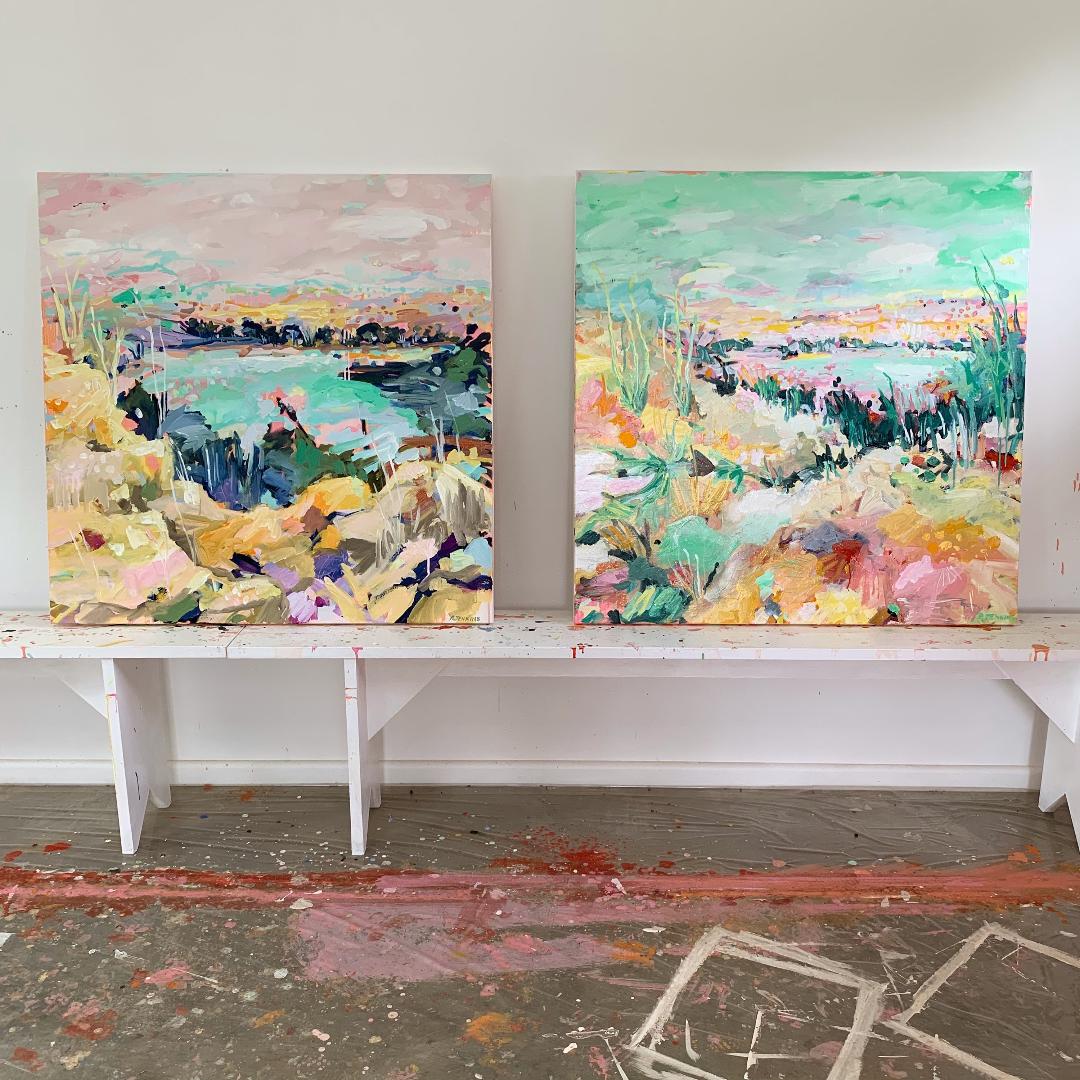
Two paintings for upcoming exhibition ‘Riverbeds and Spinifex’ in June 2020.
How does your audience interact and react to your work? What are you looking for in other artists’ work? Which shows, performances and experiences have shaped your own creative process?
I have been fortunate thus far with the engagement and response to my paintings and exhibitions. I have had near sell-out exhibitions from the outset and received wonderful support from galleries, collectors and followers which I am grateful for. I have had positive feedback from clients commenting on how they feel they relate with my landscapes, possibly because they have been there or have a connection to that landscape, and how the colours are uplifting and impact them on an emotional level. This makes me feel happy!
In other artists’ work, I look for a strong composition followed by balance between detail and calmness, light and dark, tonal elements and colour; conceptual meaning and a strong demonstration of skill.
Which shows, performances and experiences have shaped your own creative process?
The field trips and residencies I have previously undertaken have been the most influential in shaping my creative process. Being immersed in these landscapes, particularly arid and remote landscapes, and painting en plein air has allowed me to relax my painting approach and weave elements of abstraction into my pieces by painting spontaneously. This, in turn, is reflected in my larger oil paintings in the studio.
Subconsciously my local art community has also helped shape my art practice. In our small regional and creative community of Walcha in northern NSW, Australia, we have several high-profile artists including painters, printmakers, sculptors and ceramicists who are very well regarded in the arts industry. Being surrounded by and connected to these fabulous artists helps in being involved with joint projects, feedback, and support.
I gain a lot of inspiration from aboriginal art. Their use of colour and mark-making are stunning, not to mention the stories interwoven into each piece. The late Piers Bateman was a renowned Australian artist who was a friend and a big influence on my work, particularly when I was starting out. He was a brilliant landscape painter who travelled extensively in Australia and around the world to document his subjects. I’m also really fascinated with the work of Ken Done at the moment. He’s a fabulous colourist and painter. I enjoy reading about a range of artists and their journeys. I always find it fascinating to learn of their journey, their environmental influences and the external factors that shape their path.

At the ‘A Painted Landscape’ exhibition with husband Nick. 2018.
Think of the biggest professional risk you have taken. What helped you take that risk?
I have moved out of my comfort zone many times along my journey – trying new approaches and applying for new opportunities whether they be shows in large regional galleries or residencies. Nothing changes if nothing changes – so in order to progress one must take risks to move forward. Mistakes may be made along the way, or it may not go as planned, though that’s how we learn on a much deeper level and grow and develop.
What is the best piece of advice you’ve received? Why was it helpful?
The best piece of advice I have received is that progression as an artist is a slow burn. It usually can’t be rushed, and success doesn’t happen overnight. And if it does, one may have missed all the learning and knowledge along the way.
It takes time to develop one’s style and portfolio. I’m all about quality rather than quantity these days; slowing down the pace to ensure I’m producing my best art, and selecting reputable galleries and opportunities that resonate with me.
Another great piece of advice has been from my father. His famous quote is “action cures fear”. I have always carried this with me, and it has served me well. It reminds me to get out of my comfort zone, face my fears head on, and take action to make the next step, no matter how daunting.

Ridge & Spinifex, 100 x 135 cm, Oil on board. 2019. Paddington Art Prize Finalist.
Tell us about your studio. Could you describe your usual work day in the studio?
We live on a property just outside of Walcha in an old house full of character, with a big rambling garden and established trees. My studio is across the garden. My views looking out the large windows are garden out one side and undulating hills out the other, often scattered with cattle. My studio allows for plenty of light and ventilation. It’s peaceful and quiet with the only sounds being birdlife, our ducks, livestock and my music. Each day I’m accompanied by my two dogs in the studio, who look forward to ‘studio time’ and they are beautiful company. We experience very cold winters due to the high altitude, so the fire burns day in and day out during the cold season.
How do you resolve the duality between the commercial and the creative?
My utmost priority is my ability to express myself in my painting. I paint the landscapes I love, and do it intuitively. I do, however, subconsciously consider what may appeal to collectors. The commercial component of my painting practice is important to contribute towards supporting my family and my practice.
The relationship between a curator or gallery and the artist is paramount. Gallerists and artists need to be compatible and be able to work comfortably together. Not all galleries fit all artists. I’m attracted to specific because of the type of art and artists they house. For example, if I feel a gallery resonates with Australian landscapes, I am more attracted to that gallery.
I also believe one knows early on after meeting or having a conversation with a gallerist (and probably vice versa) whether they are going to work well together. Usually for me, the initial interface with a gallery involves discussing an exhibition and setting down a date and working towards that exhibition. As the exhibition comes closer, I communicate more frequently with the gallerist regarding delivery of works, catalogues, and so on. When I have them available, I often provide additional works to the galleries I’m represented by in between exhibitions.

Apsley Gorge hanging in Walcha Gallery. 140 x 280 cm, Oil on canvas.
What was your first sale? Do you handle the commercials yourself or is it outsourced to a gallery or an agent?
My first sale was from my inaugural solo exhibition at Walcha Gallery of Art in 2014 which sold out.
I choose to work with my galleries for my art sales. Painting is my priority, and, therefore, I’m very happy to outsource the commercial and freight component of my practice. The galleries I work with are very competent in promoting my work and converting enquiries to sales.
Are you more of a studio artist or naturally collaborative by nature? How do you feel about commissions?
I work with a balance between studio and en plein air. Plein air painting and spending time in the environment is essential to me in order to create larger paintings in the studio and develop a suite of paintings for an exhibition. Because my oils are multi-layered and can take weeks to complete, I work on these larger pieces in the studio. I thoroughly enjoy working en plein air when I have the opportunity as it keeps me connected with nature, its colours, tones, moods and intricacies.
I took on commissions earlier on in my practice, though I gave this up about three years ago for a few reasons. The main reason being I felt it took all my creativity out of the process and I didn’t enjoy the practice. Because I paint intuitively and spontaneously, I found it difficult to keep within tight specifications.
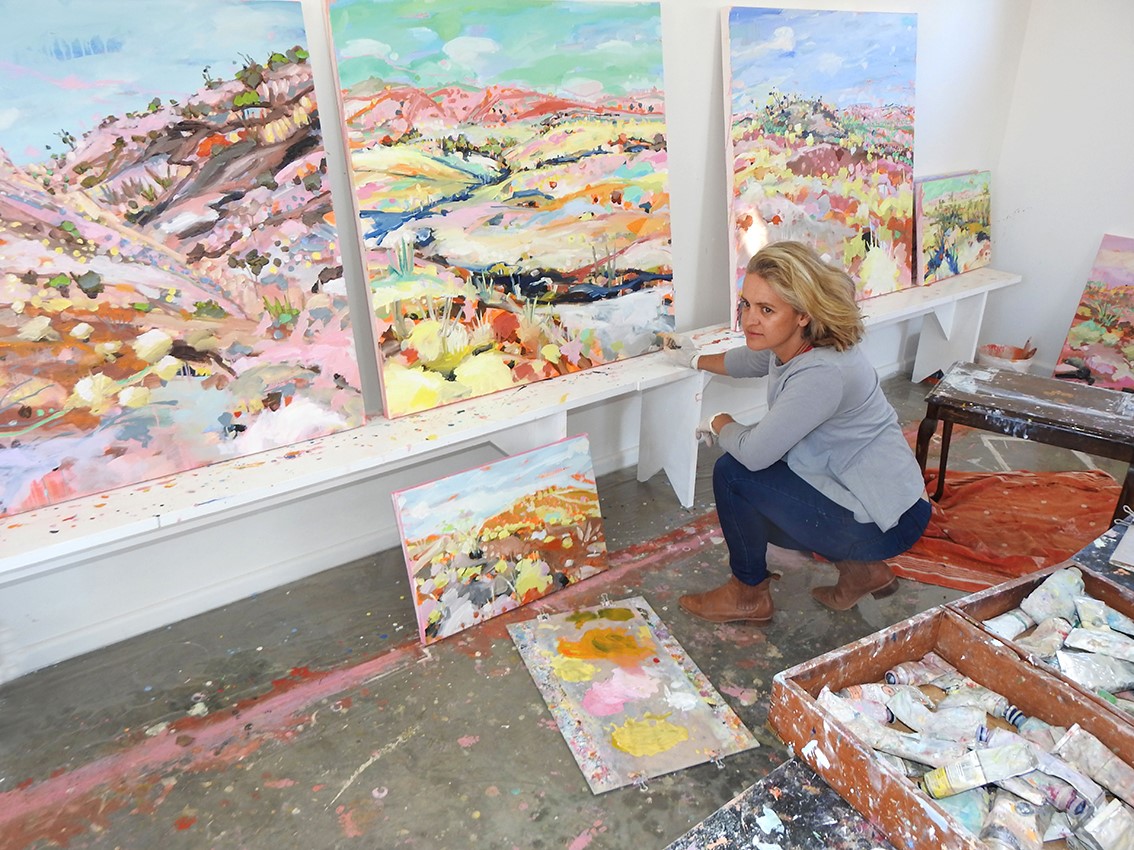
Paula in studio. 2019. Contemporary artist Paula Jenkins.
What are you working on now? What’s coming next season?
I’m currently working towards a large solo exhibition titled Riverbeds & Spinifex at the New England Regional Art Museum in Armidale, Australia, which will open on June 19 and run till the July 26. I will have around 30 paintings in this show. The theme is based on a culmination of my various painting trips to remote and arid environments within Australia. Many of the paintings will be based on my recent trip to the Finke River in Central Australia last year, which was incredibly inspirational. The landscapes there are so diverse and the colours are indicative of renowned aboriginal artist, Albert Namatjira.
I have a few exhibitions lined up over the next 2 years. May next year (2021) I look forward to my second solo exhibition at Art2Muse Gallery in Sydney, followed by a solo exhibition at another prominent regional gallery in June 2021, in addition to a selection of group exhibitions.
Before you go – you might like to browse our Artist Interviews. Interviews of artists and outliers on how to be an artist. Contemporary artists on the source of their creative inspiration.






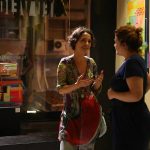


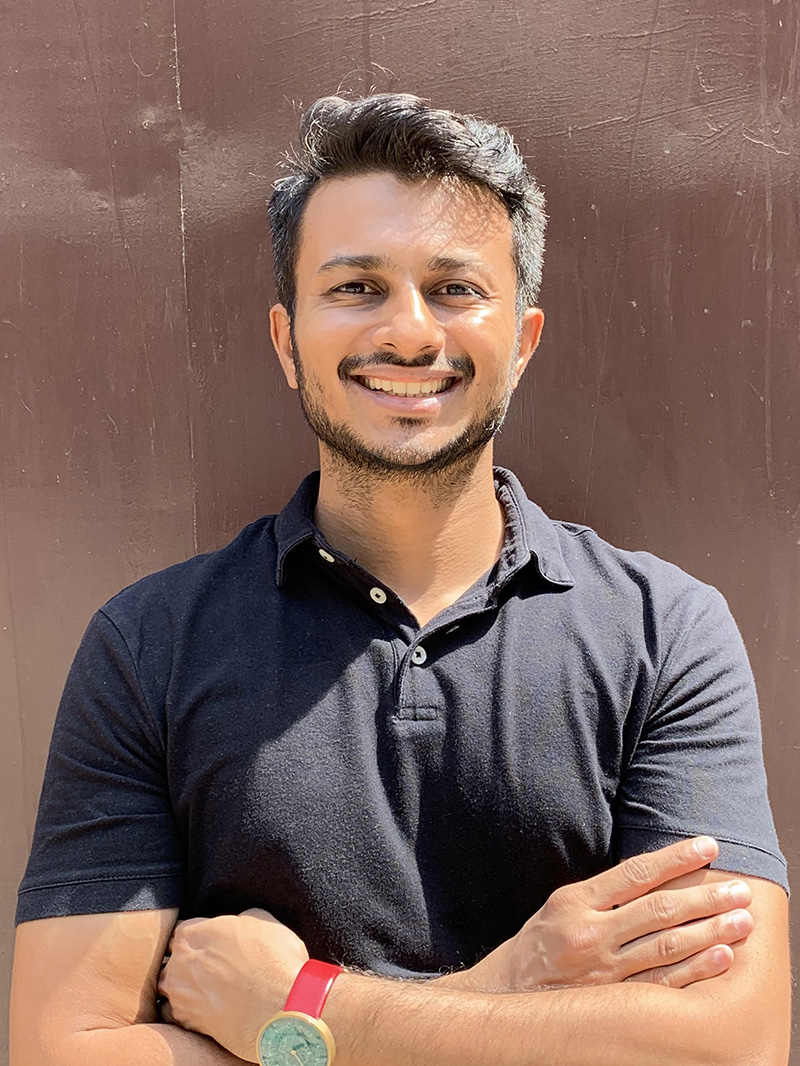

Add Comment